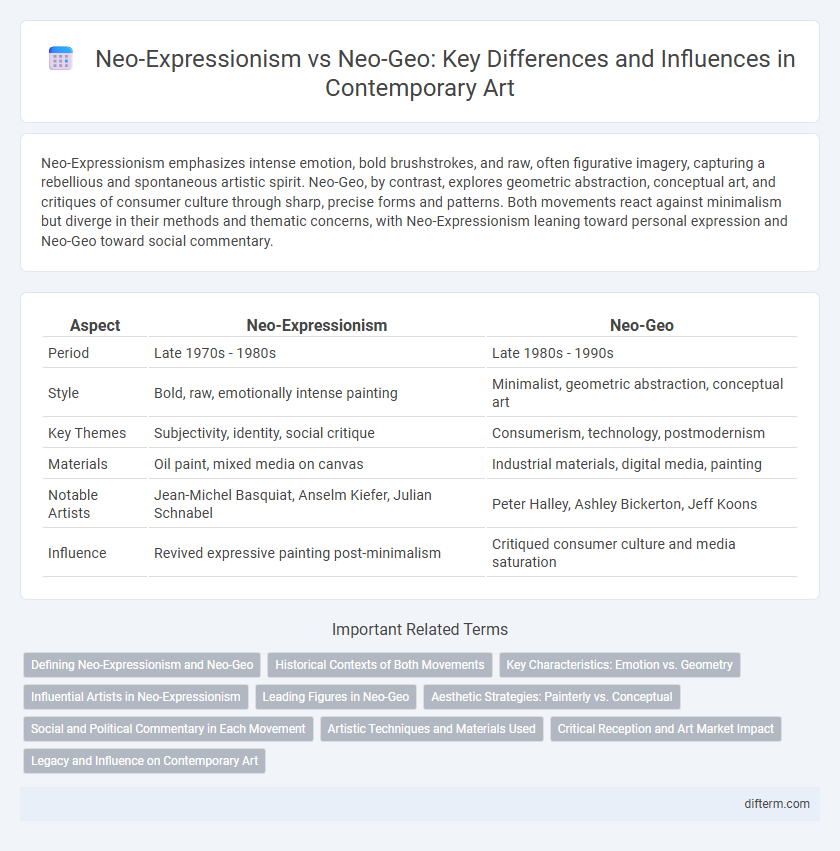Neo-Expressionism emphasizes intense emotion, bold brushstrokes, and raw, often figurative imagery, capturing a rebellious and spontaneous artistic spirit. Neo-Geo, by contrast, explores geometric abstraction, conceptual art, and critiques of consumer culture through sharp, precise forms and patterns. Both movements react against minimalism but diverge in their methods and thematic concerns, with Neo-Expressionism leaning toward personal expression and Neo-Geo toward social commentary.
Table of Comparison
| Aspect | Neo-Expressionism | Neo-Geo |
|---|---|---|
| Period | Late 1970s - 1980s | Late 1980s - 1990s |
| Style | Bold, raw, emotionally intense painting | Minimalist, geometric abstraction, conceptual art |
| Key Themes | Subjectivity, identity, social critique | Consumerism, technology, postmodernism |
| Materials | Oil paint, mixed media on canvas | Industrial materials, digital media, painting |
| Notable Artists | Jean-Michel Basquiat, Anselm Kiefer, Julian Schnabel | Peter Halley, Ashley Bickerton, Jeff Koons |
| Influence | Revived expressive painting post-minimalism | Critiqued consumer culture and media saturation |
Defining Neo-Expressionism and Neo-Geo
Neo-Expressionism is an art movement characterized by raw, emotive, and often figurative painting that emerged in the late 1970s, emphasizing intense colors and dynamic brushstrokes to convey subjectivity and personal experience. Neo-Geo, or Neo-Geometric Conceptualism, developed in the 1980s as a reaction to Neo-Expressionism, focusing on geometric abstraction, industrial materials, and conceptual critique of consumer culture and art commodification. The contrast between Neo-Expressionism's emotional intensity and Neo-Geo's detached, critical approach highlights divergent responses to postmodernism and contemporary social issues within late 20th-century art.
Historical Contexts of Both Movements
Neo-Expressionism emerged in the late 1970s as a response to Minimalism and Conceptual art, reflecting a return to figurative painting and emotionally charged, bold brushstrokes during a period marked by political and social unrest in Europe and the United States. Neo-Geo, or Neo-Geometric Conceptualism, arose in the mid-1980s, critiquing consumer culture and the commodification of art through an emphasis on geometric abstraction and industrial materials, coinciding with the rise of postmodernism and global capitalism. Both movements reflect a distinct historical reaction: Neo-Expressionism channels raw human emotions in a post-Vietnam War era, while Neo-Geo interrogates the cultural impact of technology and mass production amid economic shifts.
Key Characteristics: Emotion vs. Geometry
Neo-Expressionism emphasizes raw, intense emotion conveyed through bold brushstrokes, vivid colors, and distorted figures, capturing personal and social anxieties. In contrast, Neo-Geo focuses on geometric abstraction, clean lines, and often a mechanical aesthetic, exploring themes of consumerism and media saturation. Both movements reflect postmodern sensibilities but diverge in their approach, with Neo-Expressionism embracing chaotic expressiveness and Neo-Geo prioritizing structured visual language.
Influential Artists in Neo-Expressionism
Neo-Expressionism features influential artists such as Jean-Michel Basquiat, Anselm Kiefer, and Georg Baselitz, who emphasized raw emotion and vivid brushwork to challenge traditional artistic conventions. These artists used intense color palettes and dynamic compositions to convey personal and socio-political narratives, contrasting the cool, intellectual aesthetic of Neo-Geo artists like Peter Halley and Ashley Bickerton. The movement's impact on contemporary art can be seen in its rebellious spirit and focus on subjective experience, setting it apart from Neo-Geo's conceptual and minimalist tendencies.
Leading Figures in Neo-Geo
Leading figures in Neo-Geo include Peter Halley, Ashley Bickerton, and Jeff Koons, who emphasize geometric abstraction and conceptual critiques of consumer culture. Their works often contrast with Neo-Expressionism's emotional intensity and raw brushwork, exemplified by artists like Julian Schnabel and Anselm Kiefer. Neo-Geo artists use industrial materials and vibrant colors to explore themes of technology, capitalism, and mass media.
Aesthetic Strategies: Painterly vs. Conceptual
Neo-Expressionism emphasizes intense, emotive brushwork and vivid, gestural paint application to evoke raw human experience, prioritizing a painterly aesthetic. Neo-Geo, or Neo-Geometric Conceptualism, adopts sleek, minimal forms and repetitive geometric patterns to critique consumer culture through conceptual strategies. The contrast between the two lies in Neo-Expressionism's focus on subjective emotion and materiality versus Neo-Geo's intellectual engagement with form and social critique.
Social and Political Commentary in Each Movement
Neo-Expressionism channels raw emotional intensity and bold imagery to critique societal issues such as identity, trauma, and political unrest, often reflecting the chaos of post-war environments through figurative distortion and aggressive brushwork. Neo-Geo, emerging in the 1980s, employs geometric abstraction and irony to explore consumer culture, capitalism, and technology's impact on society, using minimalistic forms and repetition to symbolize commodification and social conformity. Both movements provide potent social and political commentary but diverge in style and thematic focus, with Neo-Expressionism emphasizing emotional turmoil and Neo-Geo critiquing systemic and cultural structures.
Artistic Techniques and Materials Used
Neo-Expressionism features vigorous brushstrokes, bold colors, and emotionally charged figures, often employing traditional materials like oil paint and canvas to convey raw intensity. In contrast, Neo-Geo artists utilize industrial materials, acrylics, and mixed media to create geometric abstraction emphasizing precision, repetition, and conceptual critique of modern consumer culture. The techniques in Neo-Expressionism prioritize spontaneous, expressive mark-making, while Neo-Geo focuses on calculated composition and surface perfection.
Critical Reception and Art Market Impact
Neo-Expressionism garnered critical acclaim in the 1980s for its raw emotional intensity and bold brushwork, appealing to collectors and commanding high auction prices, while Neo-Geo faced mixed reviews due to its conceptual minimalism and critique of consumerism. The art market favored Neo-Expressionism's vivid, figurative style, resulting in increased demand and commercial success, whereas Neo-Geo artworks attracted niche collectors interested in postmodern and critical theory themes. Both movements influenced contemporary art valuation, with Neo-Expressionism driving robust market activity and Neo-Geo contributing to conceptual art discourse and market diversification.
Legacy and Influence on Contemporary Art
Neo-Expressionism revived emotional intensity and gestural brushwork, deeply influencing contemporary artists who prioritize raw, subjective experiences and bold visual narratives. Neo-Geo's focus on geometric abstraction and critique of consumer culture paved the way for conceptual artists exploring technology, minimalism, and media critique. Together, both movements reshaped artistic dialogue by integrating personal expression with critical engagement, leaving a lasting legacy on postmodern art practices.
Neo-Expressionism vs Neo-Geo Infographic

 difterm.com
difterm.com